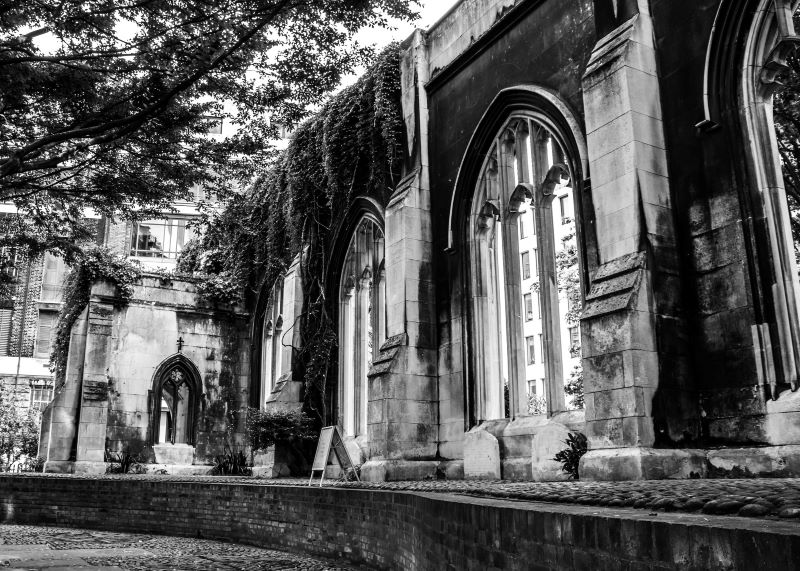One of London's hidden gems is called St Dunstan in the East and has over a thousand years of history.
Today, I'd like to introduce you to this place in detail.
St Dustan in the East: article summary
- The history of St Dustan in the East
- St Dunstan's church in Saxon times
- A legend linked to the Devil
- St Dustan in the East: at the time of the Great Fire of London
- Another blitz demolition
- Why visit this place today?
- A place for botany enthusiasts
- Are church services still held at St Dustan in the East?
- St Dunstan in the East: entrance fees and opening times
- How do I get there?
The history of St Dustan in the East
St Dunstan's chapters on Eastern history resemble an epic tale with black magic, the devil, burning buildings and casualties of war.
This structure has been present at this location for more than 900 years, or even a thousand years. it has survived much of London's turbulent history.
Viking invasions, Saxon settlements, the dissolution of monasteries, the Black Death, the Great Fire of London and the Blitz - the monument has always been there!
St Dunstan's church in Saxon times
St Dunstan's Church appeared in 1100 in Anglo-Saxon times. It owes its name to St Dunstan, a monk of the Xᵉ century.
This monk had an extremely eventful life. As a child, he battled a fatal illness and made a miraculous recovery.
Famous, he has been summoned to King Athelstan's court. He finds himself involved in a plot to bring him down.
His enemies accused him of using black magic and witchcraft, and he was thrown out of court and into a cesspool.
Later, he was covered in boils all over his body, which many thought were due to leprosy.
After his miraculous healing, he took it as a divine sign and decided to take his vows and live the celibate life of a hermit.
A legend linked to the Devil
According to legend, the Devil himself tempted Dunstan to fish, but his divine purpose kept him faithful.
Finally, the now Archbishop of Canterbury!
The church was built in his honor in the 12th century, but numerous repairs were carried out in the 14th and 17th centuries.
St Dustan in the East: at the time of the Great Fire of London
In 1666, a fire that broke out among the bakers of Pudding Lane destroyed 1,600 houses and 87 parish churches in London, including St Dunstan's Church.
It became known as the Great Fire of London and consumed around one-sixth of London at the time.
Even the historic St. Paul's Cathedral was completely burnt down and had to be rebuilt.
Another blitz demolition
During the Second World War, Germany launched a bombing campaign against the UK called The Blitz in 1940 and 1941.
Around 2 million homes and buildings have been destroyed during this period, and thousands of lives were lost.
The steeple and tower of St Dustan in the East miraculously survived, but the rest of the church structure was largely destroyed.
After the end of the war, the City of London decided not to rebuild the church, but opened it to the public in 1971.
Why visit this place today?
It's always fun to visit some of London's great sights like :
Unlike these sites, St Dunstan's is an oasis away from the hustle and bustle. It's also a testament to London's history.
A place for botany enthusiasts
If you have a particularly green thumb, you may be wondering what kind of plants grow here, amidst the Gothic ruins.
Many trees grow here through the windows, and their vines manage to wrap around the walls, through windows and cracks. There are even tropical palm trees here!
In the lower garden, you'll find the winter bark of Drimys winteri, a vitamin C-rich plant once used to treat scurvy. There are also many plants and shrubs among the climbing plants.
Are church services still held at St Dustan in the East??
Although the last indoor service took place here before the Blitz, some outdoor services still take place on the grounds near All Hallows by the Tower.
They usually hold an All Hallows procession along St Dunstan's Hill on Palm Sunday. Afterwards, they finish in St Dunstan in the East and will hold the service.
St Dunstan in the East: entrance fees and opening times
Entry to St Dunstan's in the East Churchyard is completely free all year round. So it's a great activity to experience in London if you're on a budget.
The church garden open all year round, 8 am to 7 pm.
How to get there?
St Dunstan in the East is located in the London Bridge district.
The nearest subway station to St Dustan in the East is Monument on the Circle and District line. However, you can also get out at Tower Hill station, which is also a stop on the Circle and District line.
Discovering St Dustan in the East is like entering a world of its own right in the heart of London. You'll find a quiet, green paradise surrounding a magnificent ruined church. What a real change of scenery!
What to do in London in 1 day, 2 days, 3 days, 5 days, a week?
Whatever the length of your stay, I invite you to download my special London guide.
It's free and in PDF format.
All you have to do is tell me below which e-mail address you'd like to receive it at.
EDIT: you can't enter your email?
Take the quiz at the top of this article and you'll be able to register your email address to receive the special London guide!

Leave a Reply